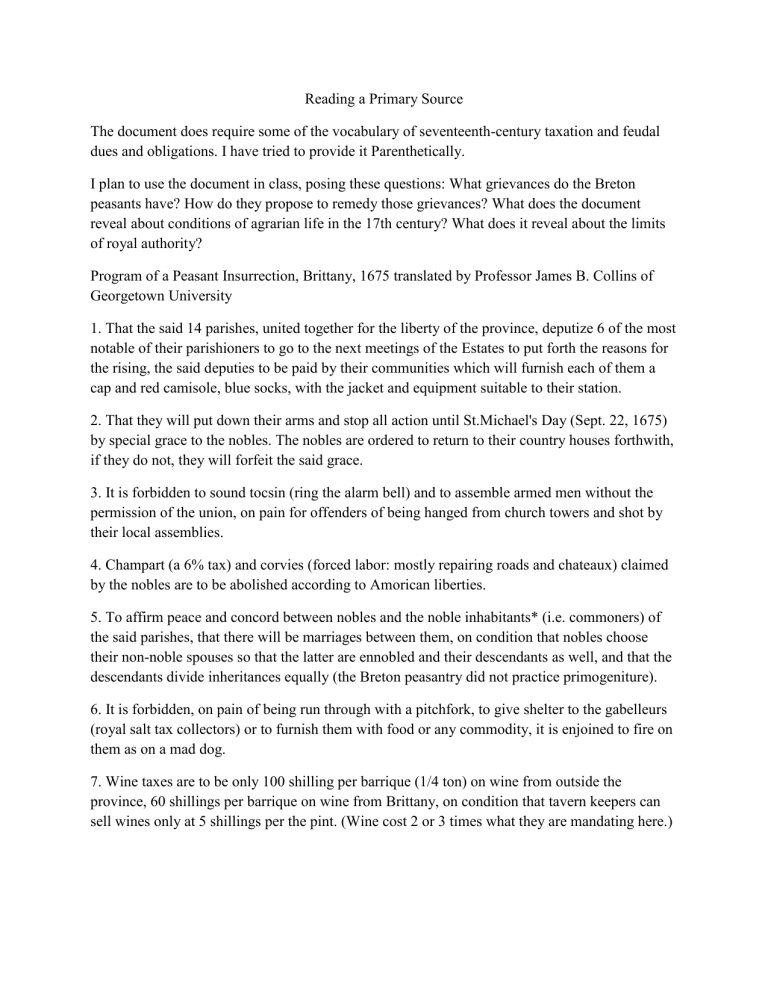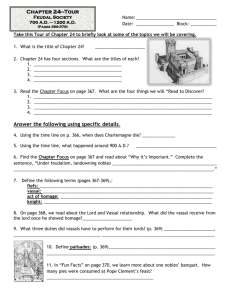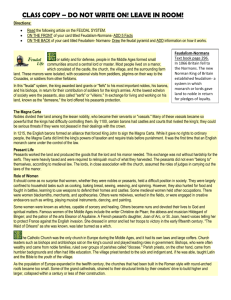How to read a primary source

Reading a Primary Source
The document does require some of the vocabulary of seventeenth-century taxation and feudal dues and obligations. I have tried to provide it Parenthetically.
I plan to use the document in class, posing these questions: What grievances do the Breton peasants have? How do they propose to remedy those grievances? What does the document reveal about conditions of agrarian life in the 17th century? What does it reveal about the limits of royal authority?
Program of a Peasant Insurrection, Brittany, 1675 translated by Professor James B. Collins of
Georgetown University
1. That the said 14 parishes, united together for the liberty of the province, deputize 6 of the most notable of their parishioners to go to the next meetings of the Estates to put forth the reasons for the rising, the said deputies to be paid by their communities which will furnish each of them a cap and red camisole, blue socks, with the jacket and equipment suitable to their station.
2. That they will put down their arms and stop all action until St.Michael's Day (Sept. 22, 1675) by special grace to the nobles. The nobles are ordered to return to their country houses forthwith, if they do not, they will forfeit the said grace.
3. It is forbidden to sound tocsin (ring the alarm bell) and to assemble armed men without the permission of the union, on pain for offenders of being hanged from church towers and shot by their local assemblies.
4. Champart (a 6% tax) and corvies (forced labor: mostly repairing roads and chateaux) claimed by the nobles are to be abolished according to Amorican liberties.
5. To affirm peace and concord between nobles and the noble inhabitants* (i.e. commoners) of the said parishes, that there will be marriages between them, on condition that nobles choose their non-noble spouses so that the latter are ennobled and their descendants as well, and that the descendants divide inheritances equally (the Breton peasantry did not practice primogeniture).
6. It is forbidden, on pain of being run through with a pitchfork, to give shelter to the gabelleurs
(royal salt tax collectors) or to furnish them with food or any commodity, it is enjoined to fire on them as on a mad dog.
7. Wine taxes are to be only 100 shilling per barrique (1/4 ton) on wine from outside the province, 60 shillings per barrique on wine from Brittany, on condition that tavern keepers can sell wines only at 5 shillings per the pint. (Wine cost 2 or 3 times what they are mandating here.)
8. That the money raised by the old hearth tax be used to buy tobacco which will be distributed at mass with the host, for the satisfaction of the parishioners.
9. The rectors, curates and priests will be salaried for the serve of their parishioners, thus having no claim to any fees in the form of tithes paid to clergy for their curatorial functions.
10. That justice be executed by capable men chosen by the noble inhabitants (i.e. commoners).
The officials of justice and their clerks will be paid, without having any right to take vacations
(cost repayments for their travels, etc.) Stamped paper (taxed at 1 sou per sheet and introduced the same year as the revolt) will be an execration to them and their descendants, and all previous acts on stamped paper are to be copied on other paper and the originals burned so that the memory of it will be effaced.
11. No hunting March 1 to September 15. Dovecotes to be destroyed and all allowed to fire on pigeons in open country. (Keeping flocks of pigeons in dovecotes was a noble privilege as was hunting game. Pigeons destroyed peasants' crops and so did hunting.)
12. That one be allowed to go to the mill of one's choice (i.e. proposed to ban the requirement to use the seigneur's mill), and that millers be forced to render flour in the same weight as grain.
13. That the town of Quimper and others adjacent be constrained by force of arms to approve and ratify the present rulings, on pain of being declared enemies of Amorican liberty and the inhabitants punished wherever they are found, an interdiction of bringing the town food or goods until they satisfy this demand will be in order, on pain of torrebanâ (head-breaking).
14.That the present ruling be read and published after high mass and on all major roads and in villages and affixed to crosses that have been put up.
*Breton peasants in revolt refer to themselves as "noble inhabitants", an honorary designation, but it is clear that they are rotaries (members of the Third Estate) and distinctly non-noble.
Selection from below from Pierre Goubert, The French Peasantry in the Seventeenth Century
(Cambridge, 1986) Trans. Ian Patteson. 105-06; 217-19
Between Henry IV and the death of Louis XIV historians have counted between 450 and 500 revolts in the huge area then covered by Aquitaine (which stretched from the Loire to the
Pyrenneses; some were small, some large, but all were marked by violence on at least the village scale, and lasted for at least a whole day. The most serious, a dozen here - half a dozen elsewhere involved whole provinces and lasted three months or more, and had to be put down by troops[Peasant revolts] occurred throughout the kingdom, and the total number of these motions
(as they were sometimes called) must be over 1,000, which puts clearer perspective on the order which reigned in the seventeenth century.
Some of these revolts took place in the towns, and did not involve the peasants at all.
Conversely, in a number of instances, the peasants were not alone in their actions; occasionally the seigneur, minor nobles, even some priests helped them or prompted them for a while, though not always out of purely generous motives (royal taxes were in competition with their own dues).
But for the short-lived riots, and some of the longer ones, the peasants had to rely on their own resources. And, when the end came, it was usually only the peasants who suffered from the inevitable repression that followed.
Despite their differences, these hundreds of revolts do have certain characteristics in common; some are predictable, others more surprising.
It is not, for example, surprising to find that almost all were directed against taxation usually royal taxation --, although some revolts in Brittany were against seigneurial dues as throughout the century taxes increased and their demands were sometimes harsh in the extreme. What is more striking is the the peasants anger and the anger of townsfolk was aroused by new taxes, which the authorities tried to levy in new ways, with new officials or clerks who often came from far away and did not speak the language of the province. Any novelty was therefore taken as an outrage, almost a sacrilege, against the customs, privileges, and the whole 'civilization' of the place. It also seems that everybody thought that the best period was always somewhere in the past before the wars, or in the time of Good King Henry, a sort of golden age accessible to everybody. With the exception of Paradise, nobody looked forward to the future, everything that altered the solidly anchored ideal of the past was seen as criminal and almost heretical.
The Breton Revolt, 1675
The issue of stamped paper (n.b.a duty of one sou per page for notarial and official documents such as bills of sale, marriage contracts, wills etc.), together with other taxes (on tin, which was very widely used, and on tobacco, which was beginning to be chewed and smoked in pipes in the
Dutch manner) designed to palliate the financial difficulties caused by the unforeseen prolongation of the war with Holland, was at the origin of the worst and oddest of the major provincial revolts, the Brenton insurrection which was first called the papier timbr (stampedpaper) insurrection, and the bonnet rouge (red-cap) insurrection. It originated in the towns, with
Rennes leading the way, and then linked the demand for provincial liberty with protests against new taxes, particularly those on stamped paper (created in 1675). As often happened, some of the nobility, magistrates, and bourgeois supported the revolt, and at least did nothing to interfere with it.
It spread rapidly and brutally into the countryside, though it was mostly limited to the cantons in the west and south of the province. Amorican liberty was their slogan, stamped paper was denounced, and the gabelle (salt tax) execrated (and compared to a female monster accompanied by her children.) But interestingly the peasants attacked chateaux as much as tax offices; they also attacked some of the wealthier religious establishments, and some towns (such as Carhaix
and Chatelin) whose bourgeois inhabitants were visibly unsympathetic. Manors were burned down, especially their archives, and nobles were beaten and driven out a dozen or more were massacred even rectors who took too much in tithes were given the same treatment as the officers or revenue and beaten up, after first experiencing the shock of seeing some of their curates among the rioters.
Since the first wave of anger had died down, the rebels decided to gather and discuss matters, under the influence of some eloquent sparkers, village scribes, minor notaries, and rich householders. They ended up by drawing up a list of complaints, thorough-going programs, eight of which (probably the most moderate) had survived. The most famous of these is signed
Torreben (break his head) and its residents and insists on the union of the communities of the parish, the liberty of the province, and the abolition of new taxes; but, more interestingly, also called for abolition of the tithes (to be replaced by a pension for priests, which was something eventually introduced after the Revolution), and the abolition of champarts and corvies claimed by the nobles and which they regarded as a violation of Amorican liberty. In fact champarts, and rights of banalities not only continued but had been increased in the course of the seventeenth century. The Breton seigneurie was particularly burdensome, but so also were in Burgundy and Saintonge, and apart from a few incidents no serious traces of resistance have been discovered in those regions. West Brittany therefore remains the only place where there was a violent revolt against both the seigneurs and the nobility which was serious enough to provoke plans for reform.
However, nothing came of these plans. Shortly before the arrival of the soldiers, preachers like
Maunoir and others took it upon themselves to promise that anybody who disobeyed the king or dared to revote would find themselves in hell. The soldiers made the promise a reality. They tortured and hanged people (fourteen from one oak tree at Combrit), filled the prison at Brest, and the galleys, and quartered themselves on the countryside for the winter, all 20,000 of them as if they were still on the other side of the Rhine as Mme de Savign wrote in December 1675
(referencing the 30 Years War). Even the governor responsible for the repression, the Duc de
Chaulnes, made suitable protests about the events to Louvois in February 1676. The churchtowers were stripped of their bells and the province was reduced to silence for over 100 years.
In addition to the Goubert book, consult the following:
Berc, Yves-Marie. Revolt and revolution in Early Modern Europe: An essay on the history of political violence. Trans. Joseph Bergin. (St.Martin's, 1987)
__________________. History of Peasant Revolts: The Social Origins of Rebellion in Early
Modern France. Trans. Amanda Whitmore (Cornell, 1986)








